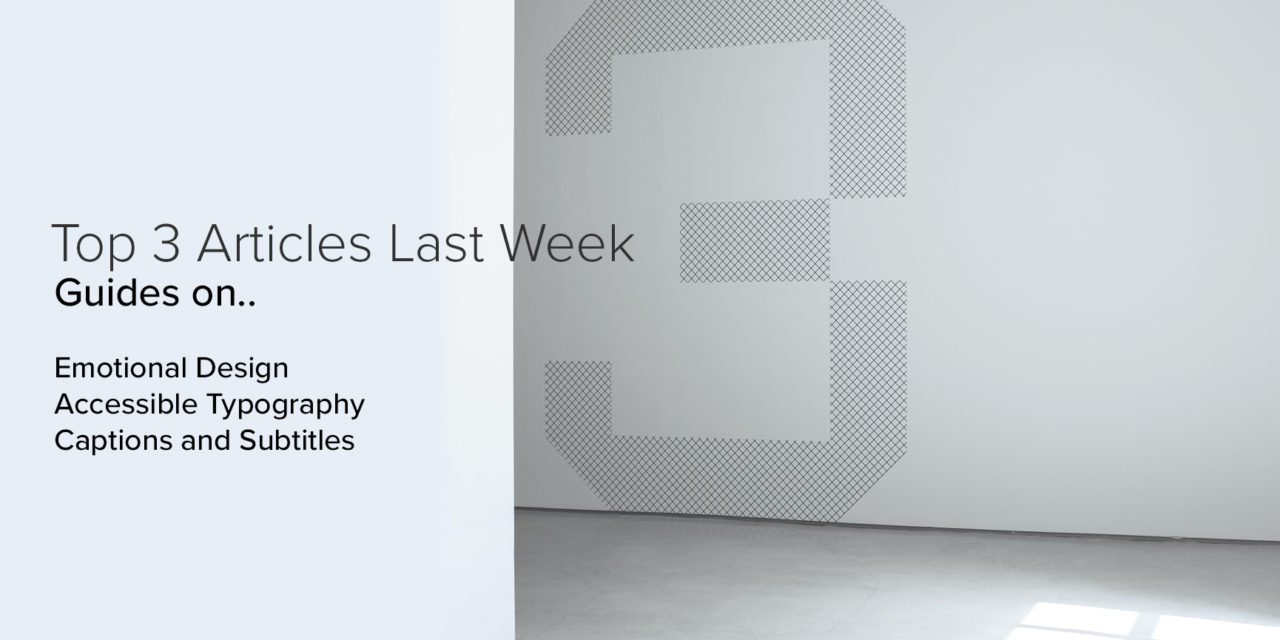The theme of the week was “guides”. We shared several articles on guides to color, usability and more this past week but our highlights are guides to effective emotional design, accessible typefaces, and closed captions and subtitles.
Usability is vitally important to your brand and to the law. These articles are great guides for making sure you are keeping up with some best practices in some areas that are often overlooked.
If we can help with these areas of your design, web or brand efforts, learn more about our team and how to contact us at www.darksquare.com
A Guid To Effective Emotional Design
ARTICLE SUMMARY: If it’s one thing we have learned from COVID-19 it is that people want connections. Connections to other people, connections to places, and connections to things.
The goal in branding is to create an emotional attachment to a product or service in an effort to foster brand loyalty that leads to repeat business.
There is a lot to achieving this goal and “A GUIDE TO EFFECTIVE EMOTIONAL DESIGN” will help guide you through the process. In great detail it will go into
- What is effective emotional design?
- How to build an emotional connection by factoring in the ‘wow-experience’
- Explain the three pillars (features) to emotional design
As Don Norman, The Grand Old Man of User Experience says, “Everything has a personality: everything sends an emotional signal. Even where this was not the intention of the designer, the people who view the website infer personalities and experience emotions.”
Human emotions are strong and as designers it is in our best interest to learn how to use emotions to our advantage for us and our clients.
A Guide To Understanding What Makes A Typeface Accessible
ARTICLE SUMMARY: The importance of type in our design cannot be understated. What is equally important is making your website “Typeface Accessible”.
When designing websites it is in our best interest to design in a way that gives access to all people. We need to take into account people with poor vision, learning disabilities, aphasia, dyslexia or low adult literacy.
“A GUIDE TO UNDERSTANDING WHAT MAKES A TYPEFACE ACCESSIBLE” by Gareth Ford Williams not only explains what exactly “Typeface Accessible” is but also a great guide on how to achieve making your websites “Typeface Accessible” for those who need it, Among the steps to achieve this are
- Using a Typeface that is Appropriate to Your Audience and The Organisation’s Brand
- Ensure there is no Mirroring.
- Avoiding Imposter Letter Shapes that are Designed to be Very Similar to Other Letter Shapes
There are many more tips in this article that will help you choose a font that will not exclude, nor slow down the reading speed of any website visitor, including those with blindness, vision loss, and reading disorders.
As designers it is our responsibility to insure access for all, not only is it the right thing to do, it’s just good business.
With the content and links provided by Gareth Ford Williams this is a great resource for all designers.
A Guide To The Visual Language of Closed Captions And Subtitles
ARTICLE SUMMARY: As accessibility becomes more and more a consideration in design one of the big items designers need to pay attention to is captions and subtitles.
There is more to this than just throwing up words on a screen and thinking you’re done with it. You need to think of what and how these subtitles are being used.
In Gareth Ford Williams’ article “A GUIDE TO THE VISUAL LANGUAGE OF CLOSED CAPTIONS AND SUBTITLES” he discusses how subtitles are used for
- Improved Accessibility
- Language Interpretation
- Help Reading Comprehension
As designers are creating more and more with accessibility in mind we need to pay attention to the guidelines in order to create effective websites that serves all our visitors. One of the big benefits to using captions and subtitles is the increase ROI and audience for media creators. There are more benefits throughout the article.
What is also good is that Gareth Ford Williams has compiled a list of resources to help you understand and how to use them.




